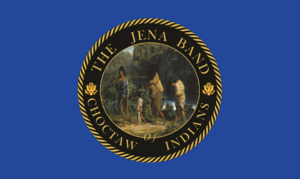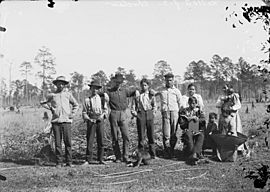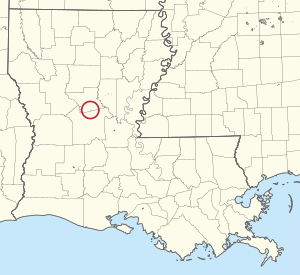Jena Band of Choctaw Indians facts for kids

flag
|
|
|
Eastern Choctaw
|
|
| Total population | |
|---|---|
| 327 | |
| Regions with significant populations | |
| Languages | |
| English, Choctaw | |
| Religion | |
| Christianity, traditional beliefs | |
| Related ethnic groups | |
| Other Choctaw tribes, Muscogee (Creek), Chickasaw, Seminole, Cherokee |
The Jena Band of Choctaw Indians (also called Jena Chahta in their language) is one of three officially recognized Choctaw tribes in the United States. They live in Louisiana, mainly in La Salle, Catahoula, and Grant parishes. The Jena Band became officially recognized by the U.S. government in 1995. They have a special land area called a reservation in Grant Parish. Their main office is in Jena, Louisiana. About 327 people are members of the tribe.
Contents
A Look Back: The History of the Jena Choctaw
The Jena Band of Choctaw Indians are related to the Mississippi Band of Choctaw Indians. Both groups come from Choctaw people who stayed in Mississippi. This was after the main Choctaw Nation moved to Indian Territory (now Oklahoma) in the 1830s. This move happened because of a treaty called the Treaty of Dancing Rabbit Creek.
Between 1870 and 1880, some ancestors of the Jena Band left Mississippi. They settled in central Louisiana. Ten main families, with last names like Lewis, Allen, Gibson, and Jackson, came to live near Jena, Louisiana. They lived on large farms called plantations owned by the Bowie and Whatley families.
Most of these Choctaw people worked as sharecroppers (sharing crops with landowners). Others worked as house helpers or day laborers (paid daily). The Bowie and Whatley families and the Choctaw group had a close, dependent relationship. People in the local area even called the band members the "Bowie Indians" or the "Whatley Indians." Many Choctaws had to buy things on credit from the Whatley family store on their plantation. The Choctaws also grew gardens to feed themselves. Choctaw men prepared deer hides, and women made baskets to sell.
Keeping Traditions Alive
The original ten families were known as "full-blood" Choctaws in the area. The Jena Band stayed mostly separate on the Whatley and Bowie lands until the 1950s. They had little contact with white people nearby. This was because of unfair treatment and the Choctaw's wish to keep their community strong.
Members of the group spoke the Choctaw language and kept their traditional Choctaw names. For example, John Allen was also known by his traditional name, Hatubbe. Jena Choctaws mostly married within their small group until the 1950s. They kept their Choctaw traditions, like their language and folklore (traditional stories).
In 1902, some members traveled to Muskogee, Indian Territory. They spoke to a group called the Dawes Commission. Their talks showed that most Jena Choctaw people who applied could only speak Choctaw. In the 1930s, reports said that most group members spoke Choctaw and no English.
Seeking Support and Recognition
Until the 1930s, the small Jena Choctaw group did not get help from the Bureau of Indian Affairs (BIA). This changed as part of President Franklin Roosevelt's "Indian New Deal." Federal officials wanted to help tribes in the Southeast that were not officially recognized but still had strong Native American roots and communities.
The BIA started a school for Jena Choctaw children during this time. The first teacher noticed that the children could not speak English. They needed help with their education right away. Because the Jena Choctaw band was small, poor, and isolated, federal officials thought about moving the families. They considered sending them to the Mississippi Band of Choctaw Indians Reservation in the late 1930s. However, there wasn't enough money to make this happen.
Modern Changes and Official Recognition
By the 1960s, many Choctaws had moved away from Jena. They went to cities like New Orleans and Houston to find jobs. But the main Jena Choctaw community stayed on lands near Jena. During this time, Jena Choctaws generally did not get involved in the growing Native American activism in Louisiana.
It was a tradition for the Band to pass leadership to the oldest male. But the last traditional leader, William Lewis, died in 1968. Also in 1968, younger Jena Choctaws began asking for economic changes. They also wanted their rights as Native Americans to be recognized.
The Louisiana Governor's Office on Indian Affairs was newly created. It aimed to help organize the band. In the early 1970s, it helped younger Jena Choctaw leaders write a formal constitution. This set up official government structures and ways to elect leaders. It also created clear rules for who could be a tribal member. At first, you needed to be one-quarter Choctaw by blood. This was later changed to 1/32 Choctaw blood.
In 1974, Jerry Jackson was elected the Jena Band's first Chairman. With money from a federal Department of Housing and Urban Development (HUD) grant, the Band built a tribal center. In the early 1980s, they also received a federal grant. This grant helped them research and write a request for official tribal recognition. They sent this request through the BIA's Federal Acknowledgment Process. The Band also worked to get tribal recognition through new laws after 1980.
Finally, in 1995, the federal government officially recognized the Jena Band as a federally-recognized tribe. This happened through the Bureau of Indian Affairs' process.
After 15 years of planning and hard work, building began on the Jena Choctaw Pines Casino. It is located in the new Town of Creola, Louisiana. The casino opened its doors in 2013.
The Jena Choctaw Reservation
The Jena Band of Choctaw Reservation (31°26′16″N 92°29′56″W / 31.43778°N 92.49889°W) is located in two separate parts. Both parts are in Grant Parish, in and near the village of Creola. The larger part is northwest of the village. The smaller part is inside the village itself.
Choctaw Culture
Choctaw culture has changed a lot over hundreds of years. It has taken in many ideas, mostly from European-American influences. It was also shaped by and added to the cultures of Spanish, French, and English colonists. The Choctaw people were known for quickly taking on modern ways. They developed a written language, changed to yeoman farming methods (small-scale farming), and welcomed European Americans and African Americans into their society. This was done through birth, adoption, or marriage.



